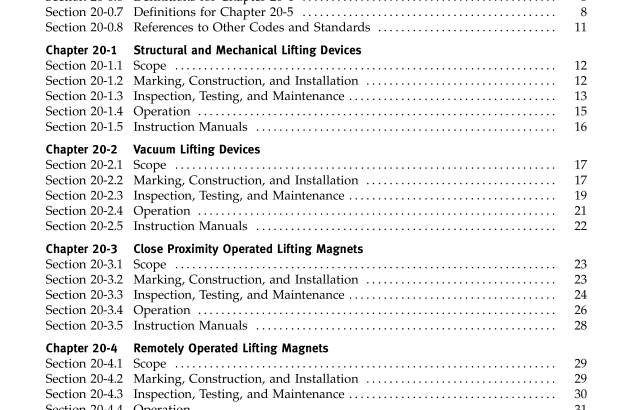ASME B30.20-2006 pdf free download.Below-the-Hook Lifting Devices Safety Standard for Cableways, Cranes, Derricks, Hoists, Hooks, Jacks, and Slings
Volume B30.20 includes provisions that apply to the marking, construction, installation, inspection, testing, maintenance, and operation of below-the-hook lifting devices, other than slings, used for attaching loads to hoist. The devices are arranged in five chapters as follows:
Chapter 20-1: Structural and Mechanical Lifting Devices
Chapter 20-2: Vacuum Lifting Devices
Chapter 20-3: Close Proximity Operated Lifting Magnets
Chapter 20-4: Remotely Operated Lifting Magnets Chapter 20-5: Scrap and Material Handling Grapples
SECTION 20-0.2: DEFINITIONS — GENERAL administrative or regulatory authority: governmental agency, or the employer in the absence of governmental jurisdiction. appointed: assigned specific responsibilities by the employer or the employer’s representative. authorized: appointed by a duly constituted administrative or regulatory authority.
below-the-hook lifting device: a device used for attaching loads to a hoist. The device may contain components such as slings, hooks, rigging hardware, and lifting attachments addressed by other standards.
design category: lifter classification that specifies the design factor to be used to establish static stress limits for the design. designated load: the specified size, shape, and weight of material to be lifted.
designated person: a person selected or assigned by the employerorthe employer’s representative as beingcompetent to perform specific duties.
hoist: a machinery unit that is used for lifting and lowering.
lifter: see below-the-hook lifting device.
lifting device: see below-the-hook lifting device. normal operating conditions: conditions during which the lifter is performing functions within the scope of the original design.
qualified person: a person who, by possession of a recognized degree in an applicable field or certificate of professional standing, or who, by extensive knowledge, training, and experience, has successfully demonstrated the ability to solve or resolve problems relating to the subject matter and work. rated load: the maximum load for which the equipment is designated by the manufacturer.
service class: lifter classification that establishes the allowable stress range for the specified fatigue life (load cycles). shall: indicates that the rule is mandatory and must be followed.
should: indicates that the rule is a recommendation, the advisability of which depends on the facts in each situation.
SECTION 20-0.3: DEFINITIONS FOR CHAPTER 20-1 chain/hand wheel: a device for manually operating a lifter. friction-type pressure-gripping lifters: lifters that grip the load withoutsignificantor harmful permanentdeforma- tion of the load surface (see Fig. 1).
grip ratio: the ratio of the sum of the horizontal forces on one side of the load to the live weight of the load. For example, if the total horizontal force on one side of the load is 100,000 lb and the live load is 50,000 lb, the grip ratio is 2. For purposes of this calculation, the weight of the load does not include the weight of the lifter (see Fig. 2). gripping force: the force the lifting device exerts on the load. indentationtype pressure-gripping lifters: lifters that carry the load by applying force to indent the sides of the load (see Fig. 3).
ingot turnover grab: a manipulating lifter [Fig. 4, sketch (e)]. latch: a device for holding a lifter in the open or closed position. latch, automatic: a sequencing latch mechanism operated by lifter motion. lifting beam (spreader beam): a load-supporting lifter [see Fig. 5, sketch (a)].
lock bar sheet lifter: a supporting lifter [see Fig. 5, sketch (j)]. manipulating lifter: a lifter that rotates the load about one or more axes during the lifting process (see Fig. 4).
mechanical lifting device: a mechanism composed of two or more rigid parts which move with respect to each other for attaching a load to a hoisting device.
service, heavy: that service which involves operation within the rated load limit that exceeds normal service.
service, normal: that distributed service which involves operation with various weights within the rated load limit, or uniform loads less than 65% of rated load. service, severe: that service which involves normal or heavy service with abnormal operating conditions.
structural lifting device: a lifter consisting of an assembly of rigid parts designed to hold and attach a load to a hoisting device. supporting lifter: a lifter that carries the load on rigid projection(s) or bearing surface(s) (see Fig. 5).ASME B30.20 pdf download.ASME B30.20-2006 pdf free download
